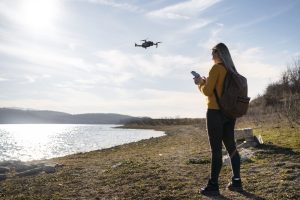Industry 4.0 represents the convergence of advanced digital technologies to optimize processes, increase efficiency, and reduce risks. Among these technologies, drones for digital twins in Industry 4.0 have become a tool for collecting accurate data and generating virtual models of industrial facilities, machinery, or infrastructure.
What is a digital twin and how do drones work in this context?
A digital twin is a virtual replica of a physical system that reflects its status in real time, allowing its behavior to be simulated, predicted, and optimized. This is achieved through sensors, IoT data, images, and advanced analytics.
Incorporating drones into this process not only speeds up information gathering, but also increases the accuracy of models and analysis capabilities.
Drones provide significant value in the creation of digital twins:
- They capture high-resolution aerial images and topographic data using LIDAR or multispectral cameras.
- They enable 3D mapping of industrial plants, warehouses, and complex environments.
- They facilitate continuous monitoring, providing up-to-date information for process simulation and prediction.
Practical applications of drones for digital twins
- Industrial inspection and predictive maintenance: drones can identify faults, wear, or damage in critical infrastructure before they become serious problems.
- Process optimization: drone-powered digital models help simulate scenarios and make strategic decisions that reduce time and costs.
- Workplace safety: By replacing manual inspections in hazardous locations, risks to workers are reduced.
- Asset and resource management: From inventory to heavy machinery tracking, drones provide accurate data in real time.
Benefits of using drones for digital twins
Some of the benefits of using drones for this purpose are:
- Constant updating of information: Thanks to the drone’s regular flights, the digital twin always reflects the current status of the plant or machinery, allowing for quick reactions to changes, optimization of processes, and keeping operations aligned with reality.
- Optimization of internal logistics: Drones can map warehouses and production areas, feeding the digital twin with real-time information on material flows, inventory location, and internal transport routes. This improves logistics efficiency and reduces travel times within the plant.
- Early detection of production line failures: Drones collect data on machinery and processes, allowing the digital twin to identify anomalies or wear and tear before they become serious problems, preventing unexpected downtime.
- Improved facility planning and expansion: With the data collected, digital twins can simulate scenarios for growth, space reorganization, or the installation of new production lines without interfering with actual operations. This facilitates strategic decision-making and reduces risks associated with changes in industrial infrastructure.
- Data-driven decision-making: Drones send real-time information to the digital twin, allowing for the analysis of reliable metrics and informed strategic decisions, rather than relying solely on estimates or assumptions. This improves efficiency and reduces risks in industrial operations.
Challenges of using drones for digital twins
Despite their benefits, the use of drones in digital twins presents major challenges such as:
- Data compatibility: systems must be able to integrate heterogeneous data, as it is obtained through different sensors and formats (images, LIDAR, thermal, etc.). Combining all this data into a single digital twin can be complex.
- Cybersecurity: The transmission and storage of large volumes of sensitive information requires robust protocols to prevent unauthorized access or cyberattacks.
- Initial implementation cost: Although it pays off in the long run, the investment in advanced drones, high-precision sensors, software, and staff training can be high.
- Dependence on connectivity and technological systems: For digital twins to be effective, drones need reliable communication networks and powerful cloud systems or local servers, which can be challenging in large or remote industrial environments.
Conclusion
Drones for digital twins in Industry 4.0 represent a key innovation that is transforming the way companies manage their assets, processes, and safety. Their ability to collect accurate data, generate virtual models, and feed advanced analytics systems makes them strategic allies in the era of digital industry.
Adopting this technology allows organizations to increase efficiency, reduce risks, and improve competitiveness, consolidating the role of digitization in modern industry.



